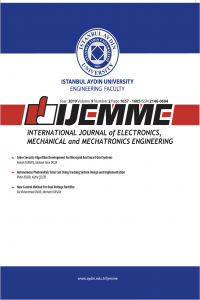Effects of Climate Change on Agriculture Production Under Rain-Fed Condition
Effects of Climate Change on Agriculture Production Under Rain-Fed Condition
___
- Asha, L.K.V., Munisamy, G., Bhat, A.R.S., 2012. Impact of climate change on rainfed agriculture in India: A case study of Dharwad. International Journal of Environmental Science and Development, Vol.3(4)
- Cline, W. R., 2007. Global warming and agriculture: Impact estimates by country. Peterson Institute of International Economics, NW, Washington, D.C., U.S.A.
- Çakmak, B., Aküzüm, T., Benli, , B., 1999. Yirmi birinci yüzyılda dünyada su sorunu (water problem on the world of 21st century). 7. Kültürteknik Kongresi (7th Culturetechnique Congress), Nevşehir, Türkiye, pp. 8-16.
- Dinar, A.R., Mendelsohn, R., Evenson, J., Parikh, A., Sanghi, K.K., McKinsey, J., Lonergen, S., 1998. Measuring the impact of climate change on Indian agriculture. Technical Report, The World Bank, Washington, D.C., U.S.A.
- Estrela, T., Vargas, E., 2012. Drought management plans in the European Union. The case of Spain. Water Resources Management 26(6):1537- 1553.
- Graham, L., Andreasson, J., Carlsson, B., 2007. Assessing climate change impacts on hydrology from an ensembly of regional climate models, model scales and linking methods-a case study on the lule river basin. Climate Changing 81:293-307.
- Grigg, N., Vlachos, E., 1989. Drought water management. A report, Colorado State University.
- Hanel, M., Mrkvickova, M., Maca, P., Vizina, A., Pech, P., 2013 Evaluation of simple statistical downscaling methods for monthly regional climate model simulations with respect to the estimated changes in runoff in the Czech Republic. Water Resources Management, 27:5261- 5279. doi: 10.1007/s11269-013-0466-1.
- Hudson, N.W., 1987. Soil and water conservation in semi-arid areas. Soil Resources, Management and Conservation Service, FAO Land and Water Development Division, Food and Agriculture Organization of the United Nations, Rome, Italy.
- http://www.cografya.gen.tr/tr/ sanliurfa/iklim.html
- IPCC., 1996. Climate change 1995: The science of climate change. In:Houghton J.T, Meira Filho L.G, Callender B.A, Kattenberg N.H.A, Maskell K (eds) Intergovernmental Panel on Climate Change. Cambridge University Press, Cambridge, England, p: 572
- Mishra, AK., Singh, VP., 2010. , A review of drought concepts. Journal of Hydrology 391(1-2):202-216
- Samadi, S., Carbone, G., Mahdavi, M., Sharifi, F., Bihamta, M., 2013. Statistical downscaling of river runoff in a semi arid catchment. Water Resources Management 27(1):117- 136. doi:10.1007/s11269-012-0170-6
- Seo, N., Mendelsohn, R., 2008. A Ricardian analysis of the impact of climate change on South American Farms. Chilean Journal of Agricultural Research, Vol. 68 (1), pp. 69-79
- Sunyer, MA., Madsen, H., Yamagata, K., 2010. On the use of statistical downscaling for assessing climate change impacts on hydrology. International workshop advances in statistical hydrology, Taormina, Italy.
- Terink, W., Hurkmans, RTWL., Torfs, PJJF., Uijlenhoet, R., 2010. Evaluation of a bias correction method applied to downscaled precipitation and temperature reanalysis data for the rhine basin. Hydrology Earth System Science Discuss 7(1):221-267
- Tsakiris, G., Spiliotis, M., 2011. Planning against long term water scarcity: a fuzzy multicriteria approach. Water Resources Management 25(4):1103-1129.
- doi:10.1007/s11269-010-9692-y
- Tsakiris, G., Nalbantis, H., Vangelis, H., Verbeiren, B., Huysmans, M., Tychon, B., Jacquemin, I., Canters, F., Vanderhaegen, S., Engelen, G., Poelmans, L., De Becker, P., Batelaan, O., 2013. A system-ased paradigm of drought analysis for operational management. Water Resources Management 27:5281-5297. doi: 10.1007/s11269-013-0471-4
- Xu, CY., Singh, VP., 2004. Review on regional water resources assessment models under stationary and changing climate. Water Resources Management
- (6):591-612. doi:10.1007/s11269- 004-9130-0
- ISSN: 2146-0604
- Başlangıç: 2011
- Yayıncı: İstanbul Aydın Üniversitesi
Computer Aided Animation Techniques for Educable Mentally Retarded Children
Turan SAĞER, Günsu YILMA ŞAKALAR, Bahadır UÇAN
Investigation of Vibration Damping in the Passenger Seat Constructions
Lütfiye DAHİL, Abdurrahman KARABULUT, Osman Nuri UÇAN
New Classificaton and Hydraulic Property Testing for Wet Unsaturated Fine-Grained Soils
The Botanical Garden of Lyon in “Le Parc De La Tête D’or”
Effects of Climate Change on Agriculture Production Under Rain-Fed Condition
Meryem KUZUCU, Funda DÖKMEN, Ayşe GÜNEŞ
